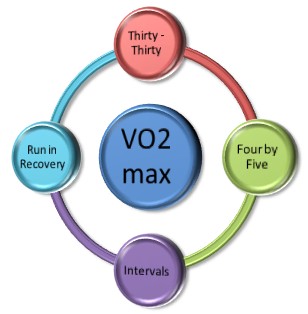Special Workouts - Billat's Four by Five and the Thirty-Thirty

She is a fast half marathoner herself (sub 1:20), coach of top runners in France, and a renowned exercise physiologist.
When she claims she has found a way which helps us how to improve performance and increase speed, runners listen.
Below are two of her workouts, the 4x5 and the 30/30. Both of them have been scientifically tested and have proven to be successful, so let's learn more about them!
What Do Veronique Billat's Workouts Do?

This is the amount of oxygen your body passes on to your muscles.
Which helps your muscles perform better.
So, in short, a higher max VO2 will help you increase speed.
Another accepted way of increasing VO2 max is via interval workouts.
Should You Focus on Improving Your VO2 Max?
Improving your VO2 max is an important part of your running, especially once you are a little bit further advanced. It's not the be all and end all. Improving your VO2 max needs to be one of the elements you focus on, not the only one. As middle- and long-distance runners, we need to first build our base. When you are starting to run and you are still working up to being able to run 30 minutes or more, you are better off to focus almost all of your efforts on easy running.
After all, a higher VO2 max (higher capability for speed) means very little if you cannot maintain that speed for a long time! So, put Veronique Billat's workouts on standby if you are not yet able to run non-stop for a longer period of time. Bookmark this page and come back to them, once you are a bit further advanced, then come do one of Ms Billat's special workouts!
Special Workout #1 - How to Improve Your Performance with the Four by Five?
The recipe is simple:
Run four times for five minutes with a 2 1/2 minute recovery jog in between.
At what speed?
She explains further that you should do this workout at a pace between tempo and interval pace. This is normally reasonably close to 5K race speed.
How fast you do this workout is quite important. Go a bit slow and you end up with a tempo run. Not a bad workout either, but if you are trying to improve your VO2max, you are much better served with going a bit faster or doing straight out intervals.
Special Workout #2 - And What About Billat's Thirty-Thirty?
The thirty-thirty is a workout with a very simple format, however it is a hard one to execute:
Alternate 30 seconds of fast running with 30 seconds of a slower jog. Do this a maximum of twenty minutes, or until exhaustion.
At what speed?
This should be done at interval pace.
Now running 30 seconds at interval pace is reasonably easy. The first time. And the second time. But after a little while the short recoveries will catch up with you. Suddenly that watch is beeping again. And you think to yourself; that can't be right, it was only five seconds ago I slowed down...
The devil with this workout is definitely in the duration, pushing yourself through the final 5 minutes.
A good way to get used to this workout is to do a shorter version of it at first. Depending on your fitness and how used you are to doing interval workouts, start with just 5-10 minutes of the thirty-thirty. Then build it up from there.
An alternative is to split it in blocks. So rather than doing 20 x 30/30 in one go, you could do 5 x 30/30. Then run easy for a couple of minutes, then do another 5 x 30/30, etc. These are pretty good ways to get used to this workout. Doing 20 x 30/30 in one go is very intense.
Important Note About Recovery: Walk or Run
Veronique Billat's team continuously do tests and studies to work out how the body reacts to different exercise regimens.

To even out the workload the "walkers" did 50% more intervals.
The results?
The runners improved their VO2max. The walkers did not. Despite doing more intervals.
Why? It is believed that the walking breaks allowed the people to recover too well, basically. It brought their heart rate down again and it meant that during the interval sessions, the runners did not spend enough time really testing VO2max.
So, when in doubt, don't walk your recovery periods, do a light jog.
The effect of walking vs jogging in recovery becomes less important when you are doing longer intervals. When you do a five minute interval, you'll be spending enough time testing your VO2max, so it matters less if you'd be walking or jogging your recovery periods.
Generally, when I do something like 5 x 1k intervals with 3 min recovery in between or so, I will jog the first few recovery periods, then the last two or three I might walk the first 30 seconds or so, then go back to a slow jog.
That is fine for these types of longer intervals.
But for short intervals, Billat's message is that you need to run/jog in your recoveries.
What Do I Think of the Workouts

But.... there is a time and place for these workouts in your running routine.
As stated before, for us middle- and long-distance runners, a lot of our focus should be on easy running. After that, build your body's ability to process lactic acid by doing tempo running. After that, building up your VO2 max and improving your speed is the icing on the cake.
So, these workouts should be your icing on the cake. In a 12-18 week running program, both of these may feature only once, depending on the distance you are training for. For the shorter distances (up to 5k-10k) your chances of doing intervals and Billat's workouts are higher. When training for half and full marathon, you generally don't do many interval sessions, so you may not do them at all.
The good thing about these workouts is that they take limited time to complete. Including a warm-up and cool-down you can be done within the hour. So, they are pretty efficient. If time is a factor for you and you can't quite fit in a longer interval workout, resorting to Billat's 30/30 is an excellent way to get a high quality VO2max workout in.
My lunch break is not overly long (as for most people), and I quite often run at lunch time, so Billat's 4x5 and the 30/30 work reasonably well for my lunch breaks.
All in all, they are good replacements for the standard interval sessions (like 12 x 400, 6 x 800 etc.), which take longer to complete.
And it is always good to get a bit of extra variation into your schedule.
So, do the Billat everyone!
Home > Running Training > Veronique Billat's Running Workouts






